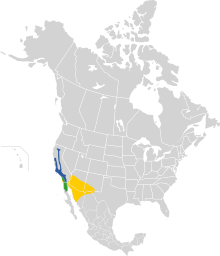Masked Siskin
| Masked Siskin | ||||||||||||
|---|---|---|---|---|---|---|---|---|---|---|---|---|

Masked Siskin ( Spinus lawrencei ) |
||||||||||||
| Systematics | ||||||||||||
|
||||||||||||
| Scientific name | ||||||||||||
| Spinus lawrencei | ||||||||||||
| ( Cassin , 1852) |
The Lawrence's Goldfinch ( spinus lawrencei , Syn. : Carduelis lawrencei ) is a bird art from the subfamily of the Stieglitz-like . The species occurs exclusively in western North America.
Appearance
The masked siskin reaches a body length of 12 centimeters. There is a gender dimorphism .
The males resemble those of the golden siskin , but, unlike them, have a yellow instead of a white wing band. The black face mask extends from the head to the throat. The eye region as well as the neck and the flanks are gray. The masked siskin is yellowish gray on the upper side of the body. In winter plumage , the plumage overall somewhat brownish and dull.
The females lack the black face mask, their plumage is less contrasting overall. The eyes and feet are black and the beak is horn colored.
Distribution area
The masked siskin is considered a very nomadic species. It breeds in a region that stretches from Shasta County , California to northern Baja California . In its range, it is predominantly restricted to the mountain ranges of the Pacific coast. Annually recurring broods are found mainly in the Carmel Valley and the southern arm of the Kern River . The choice of its breeding area is determined by the availability of water and food resources. In years with very little rainfall, it breeds more and more near the coast. There are also isolated brood specimens for Arizona .
Masked siskins are largely migratory birds. The populations that breed in the north, central and inland areas of southern California migrate to the lowlands of the coast and the outskirts of the California desert in the winter months. During this time they are often associated with golden siskins and Mexican siskins .
The typical breeding area is dry and has light forests and proximity to bushland with rich growth of tall annual plants. The masked siskin is also dependent on an open watering hole within 0.8 kilometers. Occasionally it breeds in the outskirts of rural settlements, but is absent as a breeding bird in deserts and dense forests. Outside of the breeding season, it inhabits very different habitats. These include deserts and suburbs.
Reproduction
The breeding season for the masked siskin begins in early spring and lasts until early summer. The pairs can be found in the large flocks in which these siskins roam before the breeding season. Once a pair has formed, it leaves the swarm and looks for suitable nesting sites. The female has the leading role. It often already carries nesting material while it is looking for a nesting site.
As a rule, the nest is built away from the nesting sites of other masked siskins. Loose colonies are occasionally observed, however, with up to ten pairs breeding in closer proximity to one another. The nest is cup-shaped and is usually found three meters above the ground. The clutch consists of three to six white-shelled eggs.
The female breeds alone. The breeding season is 12 to 13 days. The young birds can fledge at around 13 to 14 days and after a further 5 to 7 days they are so independent that they leave the parent birds to join other young birds in flocks.
supporting documents
Individual evidence
- ↑ Bielfeld, p. 87
literature
- Horst Bielfeld : siskins, giraffe, bullfinches and grosbeak. Verlag Eugen Ulmer, Stuttgart 2003, ISBN 3-8001-3675-9 .
Web links
- Spinus lawrencei inthe IUCN Red List of Threatened Species 2017.3. Listed by: BirdLife International, 2016. Retrieved January 25, 2018.
